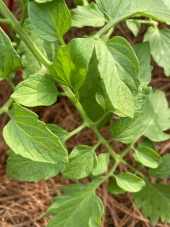








"We're all just walking each other home." -Ram Dass
"Be a lamp, or a lifeboat, or a ladder."-Rumi
"It's all one song!" -Neil Young
 1
1








Living free starts with understanding ones own emotions and emotion affects and controls us.








L. Barry wrote:I found these flies are now in my two pots of seed potatoes. What do I do with these flies when the soil for these crops needs to stay damp?
"We're all just walking each other home." -Ram Dass
"Be a lamp, or a lifeboat, or a ladder."-Rumi
"It's all one song!" -Neil Young




 2
2




L. Barry wrote:The potatoes are outdoors far away from anything else that's growing. So they are appearing both indoors and out. I've tried the vinegar and dish soap solution but they aren't interested. Maybe they aren't fruit or fungus flies? I'd snap a picture but they are far too small.
"We're all just walking each other home." -Ram Dass
"Be a lamp, or a lifeboat, or a ladder."-Rumi
"It's all one song!" -Neil Young
 2
2




Finding tiny fruit flies, or fungus gnats, loitering just above the surface of potted plant dirt is a common nuisance for indoor gardeners. These pests feed on the decaying organic matter and fungi in potting soil, although they do not cause any damage to plants. Fruit flies depend upon rotting organic debris to complete their life cycles, which is why you may also find them in the kitchen as they zero in on overripe fruits.
"We're all just walking each other home." -Ram Dass
"Be a lamp, or a lifeboat, or a ladder."-Rumi
"It's all one song!" -Neil Young








Living free starts with understanding ones own emotions and emotion affects and controls us.




L. Barry wrote:I'm in zone 2 (sub tropical) and we're actually entering into summer now. Gold Coast in Queensland to be exact.
So they may not be harmful to plants? I hope so. I've never seen them on the plants directly (heard the larvae eat the root hairs though?) so maybe that's a good sign. I'll try the sand method next.
"We're all just walking each other home." -Ram Dass
"Be a lamp, or a lifeboat, or a ladder."-Rumi
"It's all one song!" -Neil Young

 1
1




Hans Albert Quistorff, LMT projects on permies Hans Massage Qberry Farm magnet therapy gmail hquistorff
 1
1





|
This is awkward. I've grown a second evil head. I'm going to need a machete and a tiny ad ...
montana community seeking 20 people who are gardeners or want to be gardeners
https://permies.com/t/359868/montana-community-seeking-people-gardeners
|

